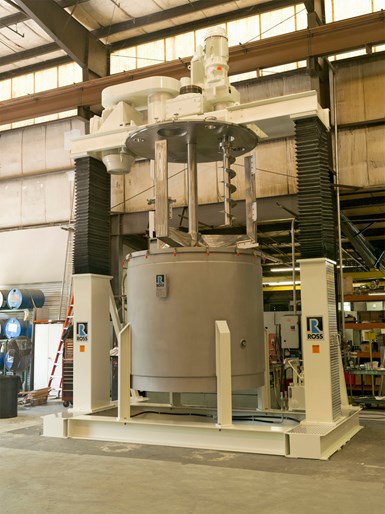Mixing: Enhancements Made to Multi-Shaft Mixer
Lifting system now operates at lower cost, requires less maintenance, and provides faster lifting speed when raising and lowering the agitators.
ROSS has made improvements to the dual-post hydraulic lift and seal design of its 1500-gal Multi-Shaft Mixer (Model PVM-1500). The new lifting design is a double-acting, fully hydraulic cylinder operating at a much higher pressure, allowing for a smaller cylinder and significantly less oil for operation. The net result is a lifting system that operates at lower cost, requires less maintenance, and provides faster lifting speed when raising and lowering the agitators, the company says. In addition, the new seal arrangement allows seal replacement without removing agitator shafts. Unlike the historical design, seal replacement no longer requires removal of the mixer from the tank nor tank entry to access the seal.

The pictured PVM-1500 features three independently driven agitators: a screw auger, a high speed disperser and a three-wing anchor agitator. The sides and bottom of the changeable mixing vessel are insulated and jacketed for up to 50 psig. This vacuum-rated machine is designed to run 24/7, supplied with rugged touchscreen controls showing digital readouts for speed, cycle time, vacuum level and batch temperature.
Related Content
-
How to Configure Your Twin-Screw Barrel Layout
In twin-screw compounding, most engineers recognize the benefits of being able to configure screw elements. Here’s what you need to know about sequencing barrel sections.
-
Engineering Resins Compounder Expands to Take on More Scrap
Polymer Resources responds to sustainability push by upgrading plant with grinding and shredding equipment to take on both postindustrial and postconsumer reclaim.
-
Configuring the Twin Screw Extruder: Part 4
For many compounding operations, material is fed to the extruder at the feed throat. This is the case when feeding a single polymer or a blend of polymers mixed with solid additives. Some ingredients, however, present a challenge in feeding. Here’s how to solve to them.


